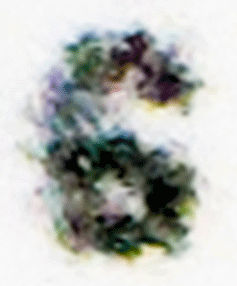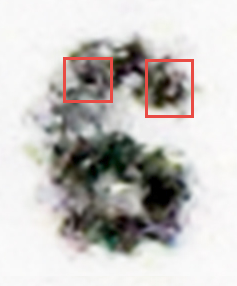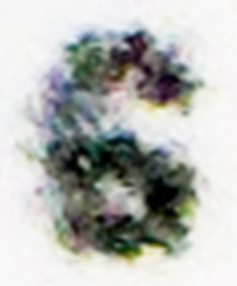On July 7th, I posted the 1:2 photo resolving power of the Sigma APO MACRO 180mm f/2.8EX DG OS HSM lens at 16 inches working distance. On July 16th, I posted the 1:2 photo resolving power of the Nikkor AF-S 300mm f/4E PF ED VR with an attached Nikon 17E II teleconverter at 48 inches working distance. Both photo systems mounted of the Nikon D500 camera. By "working distance", I mean the distance from in-front of the lens to the resolution chart. By 1:2 photo, I mean 2 times the Nikon D500 camera sensor size, which gives a photo size equal to 1.85x1.24 inches.
I have been requested to compare the above two photographic systems for taking a 1:2 photograph, one being close-up and the other 3 times further away from the subject being photographed. I prefer the further distance, but I decided to compare, in detail, how good the two systems are at making 1:2 photographs.
Note - To be more correct, the Sigma was 1:2, but the Nikkor was 1:2.2 which produced a 2.04x1.36 inch photo compare to a 1.85x1.24 inch photo for the Sigma. I am being picky because when I compare the two systems side by side, the Nikkor photo will appear slightly smaller and some people may wonder why the difference in size.
To make the comparison on equal grounds, I decide to take new photographs of my resolution chart with each system, rather than relying on past photographs. The resolution chart photographed is described in the June 9th post.
Here is a photo of the center section of the resolution chart that is photographed at 1:2 magnification. I added dimensions for this posting to show how small the width of the bars are; 0.004 inches (0.1 mm) is equal to the diameter of the average human hair.

I did the following steps to make the comparison as equal as possible. I examined each systems previous post to determine each systems sharpest f stop; it turns out both were the sharpest a f/8, so I used f/8 with both. It should be noted that Robert (RobertOToole) has posted that the Sigma 180mm lens is sharpest at f/5.6.
I mounted the two systems on a tripod and used live view and manually focused both systems. I used the Nikon MC-36 cable release to release the shutter a few seconds after removing my fingers off the lens focus ring. I set the camera at ISO 1600 inorder to use a fast shutter speed:
For the Sigma lens with OS off - f/8 at 1/1000 second,
and
For the Nikkor/TC lenses with VR off- f/8 at 1/640 second.
Man, the Sigma lens is big and heavy compared to the Nikkor lens and teleconverter. I had to mount the Sigma lens directly to the tripod, whereas, I mounted the D500 camera on the tripod when using the Nikkor/TC lenses. I compare their sizes at the end of the post.
I took three photographs with each system, being extremely careful to get the sharpest focus with each photograph.
I took raw Nef photographs. I opened the Nef files in DxO Optics Pro and exported the Nef files as Dng files: I did zero processing in DxO, especially no sharpening.
I open the Dng files in Camera Raw CS6. I processed the two system Dng files exactly the same in CR CS6: set exposure to +2.5ev, black slider to -100, shadow slider to -60, highlights to +100, whites to +8, clarity to +30, sharpening to 0, and noise reduction to 0. I did no other processing in CR CS6. I exported the processed files as Tiff files to folders on my desktop.
I opened the Tiff files in Photoshop CS6. In Photoshop, I examined the three photos from each system at 200% magnification to determine which of the three were the sharpest. I used the sharpest of the three from each system for the comparison. Other than selecting the sharpest photo, I did zero processing in Photoshop. I used Photoshop for "file>save for web" to meet the file size requirements of this forum.
Here is the 1:2 photo taken with the Nikkor 300mm f/4E PF lens plus the Nikon 17E II teleconverter mounted on the Nikon D500 camera at f/8, 1/640 sec., ISO 1600, at 48 inches working distance:

To view the photo closer, I cropped the 5568x3712 pixel photo file to 512x512 pixels:

The set of bars at #6, have a width of 0.004 inches (0.1 mm), the average thickness of the human hair. Considering this photograph was taken 48 inches from the resolution chart, the Nikon system is amazing.
If you look closely at the above 512x512px crop, you will see clusters of various colors in the numbers and on the edges of some of the bars. The photographic chart used to take the resolution photographs, was printed on glossly photoraphic paper using an Epson R3000 printer. The blacks in the photo were made up of 8 colored inks, variations of Cyan, Yellow, and Magenta inks.
To help you to see these colored ink spots, I cropped the 5568x3712px photo to 256x256px and resized it up to 1024x1024px:

The printing of the bars and numbers was not perfect, so you see these clusters of colored ink spots, primarily cyan and magenta, with a few brownish yellow spots. These colors you see are apparently not caused by chromatic aberration. Look at the numbers 5 and 6, there are clusters of cyan on the left and right sides of the numbers which is not possible with chromatic aberration. Also, this photo was taken with reflected light not refractive light, so there should not be chromatic aberration.
Here are some findings which states that chromatic aberration is nearly non-existent for this Nikkor 300mm f/4E PF lens:
1) Quoting Thom Hogan http://www.dslrbodies.com/lenses/nikon- ... -s-vr.html
"Where the E (300mm f/4E PF) starts to shine compared to the lens it replaces is in the other optical parameters. Chromatic aberration, both longitudinal and latitudinal, is very well corrected. Yes, some small amount of latitudinal chromatic aberration is present, but it’s at levels where I might not even try to correct it. On the longitudinal side, I can’t find enough to even comment on in actual use, which is excellent performance for a prime lens."
2) Quoting Andrew Alexander, SLRgear Review, October 5, 2015, imaging-resource.com:
"Chromatic Aberration. The test results for the Nikon 300mm ƒ/4E PF with regard to chromatic aberration were very impressive - the lens is highly resistant, on both of our Nikon D7000 and D800e test bodies, across all apertures."
3) Quoting Gary Wolstenholme, 6 Mar 2015, ephotozine.com:
"Levels of chromatic aberrations are very well controlled, remaining comfortably below 0.5 pixel widths towards the edges of the frame. This low level of fringing should be pretty much impossible to spot in normal image taking, even with areas of high contrast towards the edges of the frame."
These clusters are made up of individual ink spots that are 2 picoliters in size, or 0.0005 inches (0.01mm) in diameter. Obviously, any individual ink spots on the edges of the bars or numbers are going to be a blur.
Moving on, here is the 1:2 photo taken with the Sigma APO MACRO 180mm f/2.8 EX lens mounted on the Nikon D500 camera at f/8, 1/1000 sec., ISO 1600, at 16 inches working distance:

To view the photo closer, I cropped the 5568x3712 pixel photo file to 512x512 pixels:

Now for the comparison between the two systems. I combined the two 512x512px photos side by side in one file using Photoshop for ease of comparison:

Comparing the two systems 512x512px crops, shows that the Sigma 180mm lens is sharper than the Nikkor 300mm lens with the 17E II TC. This result was expected since the Sigma lens is a colored corrected MACRO lens, it should be sharper. Note - the Nikkor photo is slightly smaller than the Sigma photo because it is a 1:2.2 photo whereas the Sigma is a 1:2 photos, as discussed above.
But can Photoshop improve the Nikkor 300mm photograph to make it exceptable and comparable to the Sigma 180mm lens? For those that maybe interested, I discuss this at the end of this comparison.
NOTE - the following was not expected, and was not planned to be in this comparison write-up, but I believe it could be significant to some photographers using the Sigma APO MACRO 180mm lens.
I took the Sigma photo and cropped the 5568x3712 pixels to 256x256 pixels and resized it to 1024x1024 pixels:

Here is what really surprised me, it was totally unexpected,
"WHERE ARE ALL OF THE CLUSTERS OF COLOR INK?"
There are a few small spots of cyan, few spots of magenta, and a couple yellowish spots, but most all colored clusters are gone. Compare the numbers "5" and "6", all the cyan clusters are gone and replaced with black clusters. The Sigma APO MACRO 180mm lens is so well color corrected that it removed practically all the color clusters and replaced them with black. However, there is the possibility that the color elimination problem is with my copy of the lens and not all other copies.
The significance of this finding (if true) is that, if I am photographing a very colorful insect, bug, butterfly, with the Sigma APO MACRO 180mm lens, I may not record all the color spots on these critters, some colored spots may appear black!
But what if the Nikkor 300mm f/4E PF lens is seeing colors that are not there?
I took my Bausch & Lomb 7 times magnifier and placed it directly on the resolution chart surface and look at the charts' smallest bars and numbers. No good, the bars and numbers are to small to distinguish any colors. WHAT IRONY, I can easily make out the smallest details and colors in the resolution chart with the front of my 300mm f/4E PF lens "4 FEET" away from the resolution chart, but I cannot see these colors with my Bausch & Lomb 7x magnifier sitting on top of the chart! This Nikkor lens is really sharp!
So far, I have not answered the question "is the Nikkor 300mm lens seeing colors that are not there?"
Then I had an idea, I'll photograph the chart with my AF-S VR Micro-Nikkor 105mm f/2.8G IF ED lens and see if this lens sees the colors.
I took 3 - 1:2 photographs with the Nikkor 105mm f/2.8G lens at f/8, 1/1250 sec., ISO 1600, with the front of the lens 10 inches from the resolution chart. I used live view, manually focused, processed the Nef files exactly the same in DxO, and Camera raw CS6, and selected the sharpest of the 3 photos in Photoshop CS6.
Here is the best 1:2 photo taken with the Nikkor 105mm f/2.8G at f/8, 1/1250 sec,, iso 1600, at 10 inches from the chart

To view the photo closer, I cropped the 5568x3712 pixel photo file to 512x512pixels:

Looking close-up, I could discern what look like colors. I wanted to see the colors, so I took the Nikkor 105mm photo and cropped the 5568x3712 pixels to 256x256 pixels and resized it to 1024x1024 pixels:

The Nikkor 105mm lens recorded purples, greens, cyan, magenta, yellow, and some yellowish browns. Some of these colors seen by the Nikkor 105mm are replaced by black color in the Sigma photo. From this Nikkor 105mm photo, I conclude that the colors are in the photographic print.
So, I must assume until proven otherwise, the Sigma APO MACRO 180mm f/2.8 ED lens removes some colors that are not formed be chromatic aberration, inaddition to removing chromatic aberration colors.
For those that own the Sigma APO MACRO 180mm f/2.8 ED lens please chime in, I would like to here your opinion. Especially, from Robert (RobertOToole), who has owned several of the Sigma macro lenses.
Now, off topic from the comparison. The following is for my benefit, but it may be of interest to some who might be interested in the Nikon system.
I ask myself, is the Nikkor 300mm f/4E PF+17E II system 1:2 photographs taken at 4 feet, good enough to be comparable to the Sigma 180mm lens 1:2 photographs taken at 16 inches?
The above unsharpened photographs shows that the Sigma 180mm lens is sharper than the Nikon system. So I asked myself, "can Photoshop CS6 improve the Nikkor 1:2 photographs enough to made it comparable with the Sigma system?"
Here are my findings.
I opened the best Nikkor 300mm 1:2 Tiff photograph in Camera Raw CS6, and produced several modified photographs by varying the clarity, sharpening, and sharpening detail. I varied the clarity by +50 and +100, sharpening be 25, 50, and 100, and sharpening detail by 25, 50, and 100. This combination produced 18 modified photographs.
I viewed these 18 photos in Photoshop to find the sharpest, cleanest, and clearest photograph that was not over sharpened or made to crispy.
After spending a lot of time comparing these 18 photographs, I was left with 4 photos that were processed with clarity = 50 and 100, sharpening = 25, and sharpening detail = 25 and 50.
I took these 4 Photoshop processed photos and cropped each 5568x3712 pixel photo to 256x256 pixels and placed them in one photograph for easy comparison. I also included the original, unsharpened 256x256 pixel crops for the Nikkor system and Sigma system. Here is the combined photo:

Top center is the original, unsharpened 256x256px cropped photo taken by the Nikkor 300mm+17E II lens. Bottom center is the original, unsharpened 256x256px cropped photo taken by the Sigma 180mm lens.
The 4 outer photos are the Photoshop processed photos of the 256x256px cropped photo taken by the Nikkor 300mm+17E II lens. They show that with minor processing in Photoshop, I can get good enough 1:2 close-up at 48 inches with the Nikon system.
But wait, the Sigma owners are saying, you can also process the Sigma photo in Photoshop to make it better, and right they are. Here are the Photoshop processed photos of the Sigma 180mm1:2 photos:

You can get some really nice sharp photos with the Sigma APO MACRO 180mm f/2.8 EX lens with a little sharpening in Photoshop.
Here is a side by side comparison of the Photoshop processed 1:2 photos for the Nikon system and Sigma system for minimum and maximum chosen processing parameters.

The Sigma APO MACRO 180mm lens is the clear winner, Photoshop sharpened or not Photoshop sharpened. However, the Nikkor 300mm+17E II TC combo looks good when minimally processed in Photoshop.
I am satisfied that I will get good enough 1:2 photographs with the Nikon system at 48 inches working distance. I will not have to kneel on the ground, what a relief!
For those that are curious as to how big the Sigma APO MACRO 180mm lens is compared to the the Nikkor 300mm f/4E PF + 17E II TC lenses, here is a photo of them side by side, I threw in the Nikkor 105mm f/2.8G also:

The Sigma 180mm lens weighs in at 3.6 lbs (1.63 Kg), and length 8.0 inches (200mm) vs. 2.2 lbs (1 Kg) and 7 inches (178mm) for the Nikkor 300mm+Nikon 17E II TC.
At times I will use the Sigma 180mm lens but when I do, the lens will probably be on a tripod.
Well, I thought this post ends a long series of posts showing the studies I have been doing to find a photographic system that will take good enough close-up photographs at a distance that keeps me from kneeling on the ground.
However, I am still puzzled by why my Sigma 180mm lens replaced some colors with black color, colors that my Nikkor lenses see. Now I plan to try to create a color graphic in Photoshop, that can be used to test the Sigma 180mm lens, Nikkor 300mm lens, and Nikkor 105mm lens. A test to see if colors are correctly recorded in 1:2 photographs.
Until that post, I think I will take a break.
Leon



